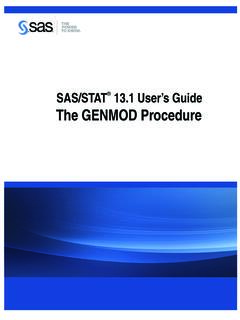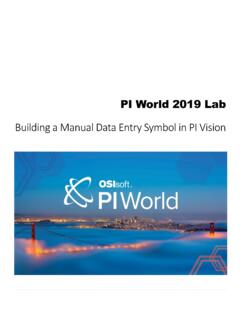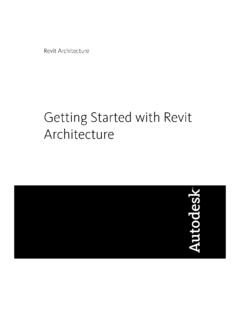Transcription of The PHREG Procedure - SAS
1 SAS/STAT user s GuideThe PHREG ProcedureThis document is an individual chapter fromSAS/STAT user s correct bibliographic citation for the complete manual is as follows: SAS Institute Inc. user s , NC: SAS Institute 2013, SAS Institute Inc., Cary, NC, USAAll rights reserved. Produced in the United States of a hard-copy book: No part of this publication may be reproduced, stored in a retrieval system, or transmitted, in any form or byany means, electronic, mechanical, photocopying, or otherwise, without the prior written permission of the publisher, SAS a web download or e-book: Your use of this publication shall be governed by the terms established by the vendor at the timeyou acquire this scanning, uploading, and distribution of this book via the Internet or any other means without the permission of the publisher isillegal and punishable by law.
2 Please purchase only authorized electronic editions and do not participate in or encourage electronicpiracy of copyrighted materials. Your support of others rights is Government License Rights; Restricted Rights:The Software and its documentation is commercial computer softwaredeveloped at private expense and is provided with RESTRICTED RIGHTS to the United States Government. Use, duplication ordisclosure of the Software by the United States Government is subject to the license terms of this Agreement pursuant to, asapplicable, FAR , DFAR (a), DFAR (a) and DFAR and, to the extent required under law, the minimum restricted rights as set out in FAR (DEC 2007). If FAR is applicable, this provisionserves as notice under clause (c) thereof and no other notice is required to be affixed to the Software or documentation.
3 TheGovernment s rights in Software and documentation shall be only those set forth in this Institute Inc., SAS Campus Drive, Cary, North Carolina 2013 SAS provides a complete selection of books and electronic products to help customers use SAS software to its fullest potential. Formore information about our offerings, call and all other SAS Institute Inc. product or service names are registered trademarks or trademarks of SAS Institute Inc. in theUSA and other countries. indicates USA brand and product names are trademarks of their respective and all other SAS Institute Inc. product or service names are registered trademarks or trademarks of SAS Institute Inc. in the USA and other countries. indicates USA registration. Other brand and product names are trademarks of their respective companies.
4 2013 SAS Institute Inc. All rights reserved. all that you need on your journey to knowledge and additional books and Greater Insight into Your SAS Software with SAS 71 The PHREG ProcedureContentsOverview: PHREG Procedure ..5909 Getting Started: PHREG Procedure ..5911 Classical Method of Maximum Likelihood ..5912 Bayesian Analysis ..5915 Syntax: PHREG Procedure ..5920 PROC PHREG Statement ..5921 ASSESS Statement ..5926 BASELINE Statement ..5927 BAYES Statement ..5934BY Statement ..5947 CLASS Statement ..5947 CONTRAST Statement ..5950 EFFECT Statement ..5953 ESTIMATE Statement ..5955 FREQ Statement ..5956 HAZARDRATIO Statement ..5956ID Statement ..5959 LSMEANS Statement ..5959 LSMESTIMATE Statement ..5960 model Statement ..5961 OUTPUT Statement ..5970 Programming Statements.
5 5973 RANDOM Statement ..5974 STRATA Statement ..5976 SLICE Statement ..5977 STORE Statement ..5977 TEST Statement ..5977 WEIGHT Statement ..5979 Details: PHREG Procedure ..5979 Failure Time Distribution ..5979 Time and CLASS Variables Usage ..5980 Partial Likelihood Function for the Cox model ..5984 Counting Process Style of Input ..5986 Left-Truncation of Failure Times ..5987 The Multiplicative Hazards model ..5987 Proportional Rates/Means Models for Recurrent Events ..59885908 FChapter 71: The PHREG ProcedureThe Frailty model ..5990 Proportional Subdistribution Hazards model for Competing-Risks Data ..5991 Hazard Ratios ..5995 Newton-Raphson Method ..5998 Firth s Modification for Maximum Likelihood Estimation ..5998 Robust Sandwich Variance Estimate ..6000 Testing the Global Null Hypothesis.
6 6000 Type 3 Tests ..6001 Confidence Limits for a Hazard Ratio ..6002 Using the TEST Statement to Test Linear Hypotheses ..6004 Analysis of Multivariate Failure Time Data ..6005 model Fit Statistics ..6014 Schemper-Henderson Predictive Measure ..6014 Residuals ..6015 Diagnostics Based on Weighted Residuals ..6018 Influence of Observations on Overall Fit of the model ..6019 Survivor Function Estimators ..6019 Effect Selection Methods ..6024 Assessment of the Proportional Hazards model ..6025 The Penalized Partial Likelihood Approach for Fitting Frailty Models ..6027 Specifics for Bayesian Analysis ..6030 Computational Resources ..6040 Input and Output Data Sets ..6040 Displayed Output ..6042 ODS Table Names ..6050 ODS Graphics ..6053 Examples: PHREG Procedure ..6054 Example : Stepwise Regression.
7 6054 Example : Best Subset Selection ..6061 Example : Modeling with Categorical Predictors ..6063 Example : Firth s Correction for Monotone Likelihood ..6071 Example : Conditional Logistic Regression for m:n Matching ..6073 Example : model Using Time-Dependent Explanatory Variables ..6077 Example : Time-Dependent Repeated Measurements of a Covariate ..6084 Example : Survival Curves ..6090 Example : Analysis of Residuals ..6097 Example : Analysis of Recurrent Events Data ..6099 Example : Analysis of Clustered Data ..6109 Example : model Assessment Using Cumulative Sums of Martingale Residuals6115 Example : Bayesian Analysis of the Cox model ..6127 Example : Bayesian Analysis of Piecewise Exponential model ..6138 Example : Analysis of Competing-Risks Data.
8 6142 References ..6148 Overview: PHREG ProcedureF5909 Overview: PHREG ProcedureThe analysis of survival data requires special techniques because the data are almost always incompleteand familiar parametric assumptions might be unjustifiable. Investigators follow subjects until they reach aprespecified endpoint (for example, death). However, subjects sometimes withdraw from a study, or the studyis completed before the endpoint is reached. In these cases, the survival times (also known as failure times)arecensored; subjects survived to a certain time beyond which their status is unknown. The uncensoredsurvival times are sometimes referred to aseventtimes. Methods of survival analysis must account for bothcensored and uncensored types of models have been used for survival data. Two of the more popular types of models are theaccelerated failure time model (Kalbfleisch and Prentice 1980) and the Cox proportional hazards model (Cox 1972).
9 Each has its own assumptions about the underlying distribution of the survival times. Twoclosely related functions often used to describe the distribution of survival times are the survivor functionand the hazard function. See the section Failure Time Distribution on page 5979 for definitions. Theaccelerated failure time model assumes a parametric form for the effects of the explanatory variables andusually assumes a parametric form for the underlying survivor function. The Cox proportional hazards modelalso assumes a parametric form for the effects of the explanatory variables, but it allows an unspecified formfor the underlying survivor PHREG Procedure performs regression analysis of survival data based on the Cox proportional hazardsmodel. Cox s semiparametric model is widely used in the analysis of survival data to explain the effect ofexplanatory variables on hazard survival time of each member of a population is assumed to follow its own hazard function, ,expressed as.
10 TIZi/D /where an arbitrary and unspecified baseline hazard function,Ziis the vector of explanatory variablesfor theith individual, and is the vector of unknown regression parameters that is associated with theexplanatory variables. The vector is assumed to be the same for all individuals. The survivor function canbe expressed Rt0 the baseline survivor function. To estimate , Cox (1972, 1975)introduced the partial likelihood function, which eliminates the unknown baseline hazard accountsfor censored survival partial likelihood of Cox also allows time-dependent explanatory variables. An explanatory variable istime-dependent if its value for any given individual can change over time. Time-dependent variables havemany useful applications in survival analysis. You can use a time-dependent variable to model the effect ofsubjects changing treatment groups.












